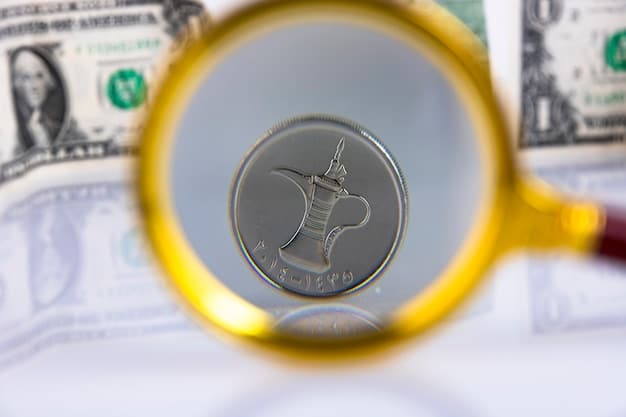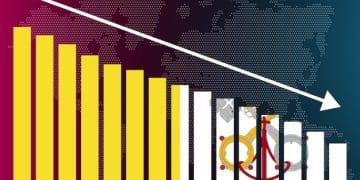Projected 2025 Inflation & Financial Protection Strategy

Anúncios
Navigating the financial landscape of 2025 demands an understanding of projected inflation rates, which economists anticipate will stabilize but remain a factor in purchasing power, necessitating proactive strategies like diversified investments and debt management to safeguard personal finances.
Anúncios
As we approach 2025, a critical question for individuals and households alike is: What are the Projected Inflation Rates for 2025 and How Can You Protect Your Finances? Understanding the trajectory of inflation is paramount to making informed financial decisions and ensuring your hard-earned money retains its purchasing power. This article delves into expert forecasts, economic indicators, and actionable strategies to help you navigate the financial landscape ahead.
Understanding Inflation: The Basics and Beyond
Inflation, at its core, refers to the rate at which the general level of prices for goods and services is rising, and consequently, the purchasing power of currency is falling. It’s a natural phenomenon in growing economies, but when it becomes volatile or sustained at high levels, it can significantly erode savings and diminish living standards. For 2025, understanding its nuances is crucial.
Anúncios
The primary drivers of inflation are often a mix of demand-pull and cost-push factors. Demand-pull inflation occurs when aggregate demand in an economy outpaces the supply of goods and services, leading to higher prices. This can be fueled by robust consumer spending, government stimulus, or easy monetary policy. On the other hand, cost-push inflation arises from increases in the cost of production, such as rising wages, energy prices, or raw material costs, which businesses then pass on to consumers through higher prices.
Key Indicators of Inflation
Several key economic indicators provide insights into inflationary pressures. The Consumer Price Index (CPI) measures the average change over time in the prices paid by urban consumers for a market basket of consumer goods and services. The Personal Consumption Expenditures (PCE) price index, preferred by the Federal Reserve, measures the prices of goods and services purchased by consumers.
- Consumer Price Index (CPI): Broad measure of consumer prices, including housing, food, and transportation.
- Personal Consumption Expenditures (PCE) Price Index: Broader measure of consumer spending, reflecting changes in consumption patterns.
- Producer Price Index (PPI): Measures average changes in selling prices received by domestic producers for their output, indicating future consumer price trends.
- Wage Growth: Rising wages can lead to higher production costs and increased consumer spending power, both contributing to inflation.
Monitoring these indicators allows economists and financial analysts to forecast future inflation trends. It’s a complex interplay of forces, and predicting the exact rate of inflation is more an art than a precise science. However, by analyzing these metrics, we can form educated projections.
Current global economic conditions, including geopolitical tensions, supply chain resilience, and shifts in global trade, also play a significant role. For instance, disruptions in critical supply chains can lead to temporary, or even persistent, inflationary spikes. Similarly, policy decisions, both domestic and international, can influence price stability. Therefore, a holistic view of the economic landscape is essential for accurate forecasting.
Projected Inflation Rates for 2025: Expert Consensus and Forecasts
Forecasting inflation several years out is inherently challenging, as it depends on a multitude of variables that can shift unexpectedly. However, financial institutions, central banks, and reputable economic research firms dedicate significant resources to providing informed projections. As we look towards 2025, there is a developing consensus among economists, albeit with some variations.
Many leading financial institutions, including major banks and research organizations, are projecting a moderation in inflation rates by 2025 compared to the elevated levels seen in recent years. The general expectation is for inflation to trend back towards the Federal Reserve’s target rate of around 2%, but with lingering uncertainty. This outlook is supported by factors such as the anticipated normalization of supply chains, the impact of tighter monetary policies already implemented, and a potential slowdown in consumer demand.
Key Projections from Leading Institutions
Various institutions offer slightly different projections, reflecting their proprietary models and assumptions about future economic conditions. For instance, some may project inflation closer to 2.5%, while others might foresee it dipping slightly below 2% before stabilizing. These variations often hinge on differing views regarding labor market dynamics, energy prices, and the pace of global economic growth.
- Federal Reserve: The Fed’s projections typically indicate a gradual return to their 2% target, assuming continued effectiveness of their monetary policy tools.
- IMF (International Monetary Fund): The IMF often provides global and country-specific inflation forecasts, generally aligning with a downward trend from recent peaks.
- Major Banks (e.g., JPMorgan, Goldman Sachs): These institutions often publish detailed economic outlooks, with 2025 inflation projections usually within the 2-3% range.
- Academic and Independent Research Firms: Various economic think tanks also contribute to the consensus, offering nuanced perspectives on potential risks and opportunities.
Despite the overall trend towards moderation, experts also highlight several potential headwinds that could influence these projections. Geopolitical instability remains a significant risk, capable of disrupting energy markets or trade routes, leading to unexpected price hikes. Persistent labor shortages and strong wage growth could also exert upward pressure on prices, making it harder for inflation to return to its target smoothly.
Furthermore, the long-term impact of fiscal policies and government spending decisions will play a role. If governments continue substantial spending, it could stoke demand and add to inflationary pressures. Conversely, if fiscal austerity measures are implemented, it could dampen economic activity and help cool prices. Therefore, the 2025 inflation outlook remains a dynamic forecast, subject to continuous refinement based on evolving global and domestic conditions.
Impact of Inflation on Personal Finances
Whether inflation is high or low, its presence undeniably impacts personal finances. Even at moderate levels, inflation slowly erodes the purchasing power of your money, meaning that over time, your dollars buy fewer goods and services. Understanding this erosion is the first step in formulating protective strategies.
Your daily expenses are directly affected. The cost of groceries, transportation, housing, and utilities typically increases with inflation. This means that a fixed income or static savings will have less real value each year. For individuals on fixed incomes, such as retirees relying on pensions or social security, this presents a significant challenge to maintaining their desired standard of living.
Impact on Savings and Investments
Savings held in traditional accounts, like regular savings accounts or checking accounts, are particularly vulnerable to inflation. If the interest rate earned on these accounts is lower than the inflation rate, your money is effectively losing value in real terms. This necessitates finding investment avenues that can at least match, if not exceed, the rate of inflation.
- Erosion of Savings: Cash loses real value if not invested or earning sufficient interest.
- Fixed-Income Securities: Bonds with fixed interest rates become less attractive as inflation rises, reducing their real return.
- Equity Markets: While stocks can offer a hedge against inflation in the long term, they can be volatile in periods of high inflation or economic uncertainty.
- Real Estate: Often considered an inflation hedge as property values and rental income tend to rise with prices.
For investments, the story is more nuanced. While some assets can act as a hedge against inflation, others may suffer. Fixed-income investments, such as traditional bonds, may offer lower real returns if inflation outpaces their yield. Equity markets can be resilient in the long run, as companies ideally pass on higher costs to consumers, leading to increased revenues. However, short-term volatility can occur as companies adjust to inflationary pressures and central banks respond with monetary policy changes.
Debt also plays a role. While high inflation might seem to lighten the burden of fixed-rate debt in real terms (as future repayments are made with cheaper dollars), it can make new borrowing more expensive due to higher interest rates set by central banks to combat inflation. This can affect mortgage rates, car loans, and credit card interest, making new purchases pricier in the financing aspect.
Ultimately, the impact of inflation underscores the importance of financial planning that considers the real value of money over time. It compels individuals to move beyond nominal returns and think about the purchasing power their assets will retain in the future. Proactive measures are necessary to mitigate these financial pressures.
Strategies to Protect Your Finances from Inflation
Protecting your finances from the corrosive effects of inflation requires a proactive and diversified approach. Simply holding cash or low-interest savings accounts is rarely a viable long-term strategy when prices are consistently rising. The goal is to ensure your assets grow at a rate that either matches or surpasses inflation, thereby preserving or enhancing your purchasing power.
One of the most fundamental strategies is investing in assets that historically perform well during inflationary periods. This often includes real assets and certain types of equities. Real assets, like real estate, tend to see their values appreciate with inflation, and rental income can also typically adjust upwards. Commodities, such as gold, silver, or oil, are sometimes considered inflation hedges, though their performance can be volatile.
Diversify Your Investment Portfolio
A well-diversified portfolio is your best defense. This means spreading your investments across various asset classes, industries, and geographies to reduce risk. Diversification ensures that if one asset class underperforms due to inflation, others may compensate.
- Stocks (Equities): Focus on companies with strong pricing power, meaning they can pass increased costs to consumers without losing significant market share. Sectors like consumer staples and utilities can sometimes perform well.
- Real Estate: Property values and rental income often rise with inflation, making it a powerful long-term hedge. Consider REITs (Real Estate Investment Trusts) for indirect exposure.
- Inflation-Protected Securities (TIPS): Treasury Inflation-Protected Securities are government bonds whose principal value adjusts with the Consumer Price Index (CPI), directly protecting against inflation.
- Commodities: Gold and other raw materials can be a hedge against inflation, although they can be volatile. Consider a small allocation.
Beyond asset allocation, managing your debt effectively is crucial. If you have fixed-interest rate debt, inflation can actually reduce the real cost of debt over time. However, if you have variable-rate debt, rising interest rates—often a response to inflation—can make your payments significantly more expensive. Prioritizing the repayment of high-interest, variable-rate debt can safeguard your cash flow. Consider refinancing variable-rate debt into fixed-rate options if market conditions are favorable.
Increasing your income streams is another powerful inflation-fighting tactic. This could involve negotiating salary raises that keep pace with inflation, developing side hustles, or investing in skills that enhance your earning potential. Remember, your most valuable asset is often your ability to earn income.
Finally, maintaining an emergency fund is more important than ever. Unexpected expenses combined with rising prices can quickly deplete savings. Having a liquid fund for at least three to six months of living expenses provides a critical buffer, preventing you from having to sell investments at an inopportune time or accrue high-interest debt.
The Role of Central Banks and Government Policies
Central banks, most notably the Federal Reserve in the U.S., play a pivotal role in managing inflation. Their primary tool is monetary policy, which involves adjusting interest rates and controlling the money supply. When inflation runs hot, central banks typically raise interest rates to cool down the economy, making borrowing more expensive and thereby reducing demand. Conversely, during periods of low inflation or deflation, they may lower rates to stimulate economic activity.
For 2025, the actions of the Federal Reserve will be closely watched. Their decisions on the federal funds rate will directly influence everything from mortgage rates to business investment. The challenge for central banks is to achieve a “soft landing,” where inflation is brought under control without triggering a severe economic downturn or recession. This balancing act requires careful consideration of economic data and forward-looking projections.

Government Fiscal Policies
Government fiscal policies, which involve an administration’s decisions on spending and taxation, also significantly impact inflation. Large government spending programs, especially if financed by borrowing, can inject more money into the economy, potentially leading to increased demand and upward pressure on prices. Conversely, tax increases or spending cuts can reduce aggregate demand and help curb inflation.
- Interest Rate Adjustments: Central banks raise rates to curb inflation, making borrowing more expensive.
- Quantitative Easing/Tightening: Influencing the money supply by buying or selling government securities.
- Fiscal Stimulus vs. Austerity: Government spending and tax policies can either fuel or cool inflation.
- Regulatory Frameworks: Policies related to competition and market efficiency can also indirectly affect price levels.
In the context of 2025, various government initiatives and reforms could influence inflation. Investments in infrastructure, green energy, or technological advancements could initially contribute to demand, but over the long term, they might enhance productivity and supply, potentially mitigating inflationary pressures. Trade policies, tariffs, and international agreements also have a bearing on the cost of imported goods, directly affecting consumer prices.
The synergy or divergence between monetary and fiscal policies is critical. If central banks are tightening monetary policy to fight inflation, but governments are simultaneously implementing large fiscal stimulus packages, their efforts can counteract each other, making the battle against inflation more protracted. Therefore, an understanding of both sets of policies is essential when considering the inflation outlook for 2025 and beyond.
The credibility of both central banks and governments in their commitment to price stability plays a vital role. If the public and markets believe that policymakers are serious about controlling inflation, it helps anchor inflation expectations, which in itself can contribute to more stable prices. Conversely, a perceived lack of commitment can lead to inflation spiraling out of control.
Long-Term Financial Planning Amidst Inflationary Trends
Long-term financial planning inherently involves anticipating and mitigating the effects of inflation. It’s not just about accumulating wealth, but about accumulating wealth that maintains or increases its real purchasing power over decades. This requires a strategic mindset that looks beyond nominal returns and focuses on inflation-adjusted growth.
One of the cornerstones of long-term planning is consistent investing. Disciplined contributions to retirement accounts, brokerage accounts, and other investment vehicles allow you to take advantage of compounding returns. The longer your money is invested, the more it can grow, potentially outpacing even persistent inflation. Automating these contributions removes the psychological barrier and ensures consistency.
Rebalancing and Asset Allocation
Regularly rebalancing your portfolio is crucial. Over time, different asset classes will perform differently, causing your portfolio’s allocation to drift from your target. Rebalancing involves selling off assets that have performed well to buy those that have underperformed, bringing your portfolio back to its desired risk and return profile. This also provides an opportunity to reassess your inflation hedges.
- Regular Portfolio Rebalancing: Adjusting asset allocation to maintain desired risk profile and inflation hedges.
- Inflation-Adjusted Retirement Goals: Setting future financial goals in real terms, accounting for projected inflation.
- Invest in Human Capital: Continuously acquiring new skills and education to enhance earning potential.
- Estate Planning: Ensuring your wealth transfer plans account for future purchasing power.
For those nearing or in retirement, developing an inflation-aware withdrawal strategy is paramount. A common mistake is to withdraw a fixed nominal amount each year, which means less purchasing power over time. Strategies like the “rule of 4%” should be adjusted to consider inflation, or a flexible spending approach that adapts to market conditions and inflation dynamics may be more appropriate.
Furthermore, investing in your human capital—your skills, knowledge, and abilities—is one of the most powerful long-term inflation hedges. Skills that are in demand, especially those that are difficult to automate, allow you to command higher wages and maintain your income’s purchasing power, independent of broader economic inflation trends. This could involve pursuing further education, professional certifications, or on-the-job training.
Lastly, estate planning needs to account for inflation. The real value of inherited assets or trust funds established today will diminish over time if not managed with inflation in mind. Discussing inflation-adjusted clauses with legal and financial advisors can ensure your legacy maintains its intended value for future generations. All these elements combined form a robust long-term financial plan designed to thrive, not just survive, in an inflationary environment.
Navigating Investment Choices for Inflation Protection
Making informed investment choices is a cornerstone of protecting your finances against inflation. While a diversified portfolio is key, understanding the specific types of investments that tend to fare better during inflationary periods can optimize your strategy. The aim is to select assets that either increase in value with rising prices or provide inflation-linked returns.
Many investors look to real estate as a primary inflation hedge. Property values and rental income often rise in tandem with inflation. Direct ownership of income-producing properties, or indirect exposure through Real Estate Investment Trusts (REITs), can provide a tangible asset that tends to hold its real value. REITs, in particular, offer liquidity and diversification typically unavailable through direct property investment, making them accessible even for smaller investors.
Considering Alternative Investments
Beyond traditional stocks and bonds, alternative investments can offer unique inflation-hedging characteristics, though they often come with higher risks and liquidity considerations. These include commodities, precious metals, and even certain types of private equity.
- Infrastructure Investments: Toll roads, utilities, and other essential services often have revenues tied to inflation.
- Private Equity/Debt: Can offer diversification from public markets and potentially higher returns, but with less liquidity.
- Dividend-Paying Stocks: Companies with strong cash flows may increase dividends, providing a rising income stream.
- Currency Diversification: Holding foreign currencies or international assets can protect against domestic currency depreciation due to inflation.
Investing in companies with strong pricing power is also a smart strategy within the equity market. These are businesses that can raise their prices without significantly impacting demand for their products or services. This ability often comes from having a strong brand, unique product offerings, or essential services. Such companies are better positioned to maintain their profit margins even as their own input costs rise due to inflation.
Precious metals, particularly gold, have long been considered a traditional safe haven during times of economic uncertainty and inflation. While gold doesn’t generate income, its value often increases as the purchasing power of fiat currencies declines. A small allocation to gold or silver can serve as a portfolio diversifier and a hedge against extreme inflationary scenarios, though it should not be the sole inflation protection strategy.
Finally, exploring TIPS (Treasury Inflation-Protected Securities) is highly recommended. These U.S. government bonds are specifically designed to protect investors from inflation. Their principal value adjusts semi-annually based on changes in the Consumer Price Index, ensuring that the real value of your investment is preserved. While their returns might be modest, they offer direct and reliable inflation protection, making them a valuable component of an inflation-aware portfolio, especially for those seeking capital preservation.
Budgeting and Debt Management in an Inflationary Environment
In an inflationary environment, meticulous budgeting and strategic debt management become even more crucial. While investments help grow your assets, effective management of your spending and liabilities directly impacts your immediate financial well-being and cash flow. Without a solid handle on these, even a robust investment portfolio might not fully buffer the strain of rising costs.
The first step is to revisit and adjust your budget to reflect current and projected costs. Inflation means that what you paid for groceries, fuel, or utilities last year is unlikely to be what you pay this year or next. Track your expenses diligently to identify where your money is going and where adjustments can be made. This might involve cutting discretionary spending, finding cheaper alternatives for essential goods, or negotiating better deals on services.
Optimizing Your Budget for Rising Costs
An inflation-aware budget isn’t just about cutting expenses; it’s also about optimizing them. Look for areas where you can reduce fixed costs, such as by refinancing a mortgage to a lower rate (if available and beneficial) or negotiating better insurance premiums. Focus on essential spending and differentiate it from wants, allowing you to prioritize your funds effectively.
- Regular Budget Review: Update your budget frequently to reflect rising costs and adjust spending habits.
- Prioritize Needs Over Wants: Distinguish between essential expenses and discretionary spending.
- Reduce Variable Debt: Pay down credit cards and other high-interest, variable-rate loans.
- Build an Emergency Fund: A robust emergency fund provides a buffer against unexpected price hikes.
When it comes to debt, distinguish between fixed-rate and variable-rate liabilities. Fixed-rate debt, like a traditional mortgage, generally becomes less burdensome in real terms during inflationary periods, as repayments are made with dollars that have less purchasing power. However, variable-rate debt, such as credit card balances or adjustable-rate mortgages, is highly susceptible to rising interest rates, which often accompany anti-inflationary measures by central banks.
Prioritizing the repayment of high-interest, variable-rate debt is a smart move. Not only does it free up cash flow, but it also reduces your exposure to fluctuating interest rates. Consider strategies like the debt snowball or debt avalanche methods to tackle these balances systematically. If you have significant variable-rate debt, explore options to consolidate or refinance it into a fixed-rate loan if market conditions permit.
Finally, negotiating and shopping around are perennial budgeting tips that become even more potent during inflation. Don’t simply accept price increases from your service providers. Call your internet, cable, or insurance companies and ask for better rates. Compare prices for groceries, gas, and other necessities across different retailers. Every dollar saved by conscious consumer behavior helps to offset the rising cost of living, effectively enhancing the purchasing power of your income.
Understanding and applying these budgeting and debt management principles ensures that your current financial state remains stable, allowing your long-term investment strategies to truly take effect.

| Key Point | Brief Description |
|---|---|
| 📈 Projected Inflation | Economists forecast moderation towards 2-3% by 2025, but with potential headwinds. |
| 🛡️ Financial Protection | Diversify investments, manage debt, and optimize budgeting to preserve purchasing power. |
| 🏠 Investment Hedges | Real estate, TIPS, and stocks of companies with pricing power can offer protection. |
| 💰 Debt Strategies | Prioritize paying down high-interest, variable-rate debt to mitigate rising costs. |
Frequently Asked Questions About Inflation and Your Finances
Inflation means your money buys less over time. For everyday spending, it translates to higher prices for groceries, gas, rent, and other goods and services, reducing your purchasing power. A stable income will feel like it’s shrinking in real terms.
No investment guarantees full protection, but Treasury Inflation-Protected Securities (TIPS) are designed to shield against it by adjusting their principal value with the CPI. Real estate and certain commodities are also often considered strong hedges, though they carry their own risks.
In an inflationary environment, reviewing your budget at least quarterly or semi-annually is highly advisable. This allows you to identify rising costs, adjust your spending habits proactively, and ensure your financial plan remains aligned with your goals and economic realities.
If you have a fixed-rate mortgage, high inflation can actually reduce the real value of your debt. However, if you have a variable-rate mortgage, rising interest rates could make payments more expensive, making accelerated payoff or refinancing a worthwhile consideration for stability.
Central banks raise interest rates to curb inflation, which makes borrowing more expensive for consumers and businesses. This can impact loan rates (mortgages, credit cards) and potentially slow economic growth. Their goal is price stability, which ultimately protects your purchasing power.
Conclusion
The journey through the financial landscape of 2025, marked by an anticipated moderation in inflation, still demands vigilance and strategic planning. While economists project rates to stabilize closer to the Federal Reserve’s target, the cumulative effect of past inflation and potential future shocks necessitates a robust approach to personal finance. Understanding the drivers of inflation, actively diversifying investment portfolios to include real assets and inflation-protected securities, and diligently managing debt are not merely recommendations but essential practices. By adopting these proactive measures, individuals can confidently navigate the economic currents, safeguarding their purchasing power and ensuring their financial well-being in the years to come.





